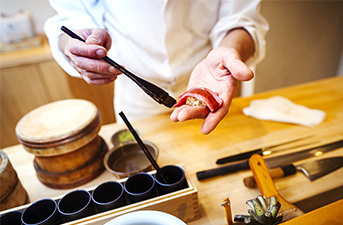Restaurants(9633)
Ginza Wakuta
Fugu in winter, sakura shrimp in spring — located close to Ginza Station, Ginza Wakuta has earned its place among the district's premier kaiseki restaurants with its signature seasonal clay pot rice.
there is ramen
This Michelin Bib Gourmand ramen shop in Ogikubo prefers to let its food speak for itself, with simple menu offerings that belie the complex flavor of its soup.
Ramen Break Beats
Chef Takuro Yanase’s unorthodox spin on ramen has attracted a lot of attention, to the point where it’s earned him a Michelin Bib Gourmand 2024. Try seasonal menu offerings or stick to the tried-and-true classics of salt and soy sauce ramen.
Hoppers
Chef Kazuhiro Ito has done it again: his Michelin Bib Gourmand award for Spice Cafe has now been followed up with one more for Hoppers in 2024.
Charcut
This Michelin Bib Gourmand-awarded Toranomon charcuterie specialist doesn’t just wow with its huge variety of cold cuts, but also the 100-plus wines in its selection.

Katsuyoshi Nihonbashi Ningyocho
Set in the “Doll Town” of Tokyo’s Nihonbashi district, the chefs behind the dark wooden counter of Katsuyoshi fry up gorgeously fatty, thick cuts of pork and other luxurious ingredients.
Jeeten
The name of this restaurant comes from the Chinese pronunciation of owner-chef Katsuhiko Yoshida’s name — similar to how Japanese yakuzen cuisine and Chinese influence come together in its kitchen.
Trattoria Buca’Massimo
The highlight of this Michelin Bib Gourmand restaurant is the bistecca alla fiorentina, a traditional Tuscan steak weighing up to 800 grams, and measuring up to four centimeters thick.
Bistro Glouton
This Ikejiri-Ohashi restaurant run by a husband-wife duo offers the quintessential French bistro experience. Classic French fare like duck confit and ratatouille employs the best of Japan’s seasonal produce.
Lien
Offering courses of flavor and sentiment, the Michelin-recognized Lien offers an intimate, insightful French dining experience. All courses are made using fresh ingredients from the chef’s hometown in Aomori for a personal touch.

Soba Osame
Pairing rustic soba with regional small plates, Soba Osame mirrors the idyllic glades and Thoreauvian mountain towns of Japan through its menu.

Tonkatsu Narikura
The characteristic white color of the tonkatsu batter at this Minami-Asagaya restaurant comes from a low-temperature frying process that gives the pork maximum juiciness — and a Michelin Bib Gourmand award.
Tohakuan Karibe
The highlight of this Michelin Bib Gourmand soba restaurant is its extensive wine selection, which changes every week at the recommendation of a sommelier. Seasonal tempura offerings keep guests coming back for more.
Yakiniku Kokonomi
This Ebisu yakiniku restaurant’s name literally means “only here”, referring to its claim to serve the “original” wagyu beef — Takenotani-tsuru beef from Okayama — that can only be eaten there.
Hiroshima Yagumo
This Hiroshima hotpot restaurant was serving shabu-shabu before it was even called shabu-shabu. Tuck into the finest Japanese beef dipped in a homemade sauce, all while surrounded by traditional Japanese folk art.
Yagumo Nagarekawa
At the Nagarekawa branch of one of the first restaurants to serve shabu-shabu, guests can enjoy the finest kuroge wagyu black beef in a homemade sauce, all while surrounded by traditional Japanese folk art.
Wagyu Amiyaki Kaiseki Sizzler
For over 50 years, this Hiroshima yakiniku restaurant has offered 25 different cuts of beef from every possible part of the cow. Each one is kuroge wagyu black beef from the Hiroshima region for maximum freshness.
Teppanryori Mimitei
Discover Hiroshima’s best-kept secret at this teppanyaki restaurant: Hiroshima beef, which has a melting point so low it literally melts in the mouth.
Shunsai Hayato
Cuisine fit for a king. Near the Korakuen Gardens, this Okayama restaurant keeps the cuisine of the feudal lords of fine otonosama-ryori alive. Feast on fresh sashimi and Chiya beef, a wagyu cattle so rare it bears the title of “phantom wagyu”.
Hondori Sasa
This central Hiroshima restaurant prepares fresh Setouchi seafood and other local seasonal ingredients through a variety of ancient grilling methods that have been all but lost to time.
Sumiyaki Kaminari Main Store
This legendary Hiroshima yakitori restaurant uses a combination of “tohbi” distant-fire charcoal grilling to seal in the flavor, as well as a tashi-tsugi sauce that has been continuously added to for over 40 years of operation.
Sumiyaki Kaminari Shintenchi
This legendary Hiroshima yakitori restaurant uses a combination of “tohbi” distant-fire charcoal grilling to seal in the flavor, as well as a tashi-tsugi sauce that has been continuously added to for over 40 years of operation.
Sumiyaki Kaminari Tatemachi
This legendary Hiroshima yakitori restaurant uses a combination of “tohbi” distant-fire charcoal grilling to seal in the flavor, as well as a tashi-tsugi sauce that has been continuously added to for over 40 years of operation.
Kagurazaka Tempura Tenko
Chef Arai Hitoshi’s family has been making tempura at his Kagurazaka restaurant for almost 50 years, and he has lectured on the subject from Paris to New York. His secret ingredient? A focus on hospitality.
Minokichi Shinsaibashi Midosuji
The best of seasonal Kyoto-style cuisine rightfully enjoyed in traditional, folk-craft-filled dining rooms.
Shimakawa
This Hakata restaurant has "conveying the seasons" with fresh seafood from the Genkai Sea for over 30 years, with local delicacies at the forefront like pufferfish, longtooth grouper, pike conger and devil stinger.
Ueno Sushi Gion
The hunt for authentic Edomae-style sushi in Tokyo can end at Ueno Sushi Gion, where seasonal nigiri is made by a chef who once trained at a Michelin-starred restaurant.
Ikebukuro Sushi Fukuju
One of Ginza’s most famous sushi restaurants opens a branch in Ikebukuro, bringing the same reputation for quality with it. Experience Edomae sushi with a Michelin star pedigree.
